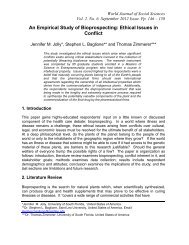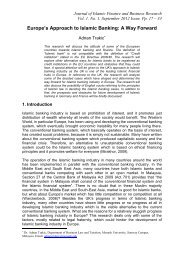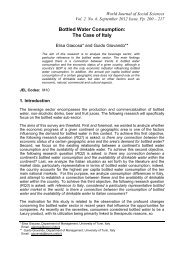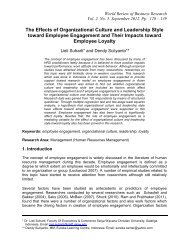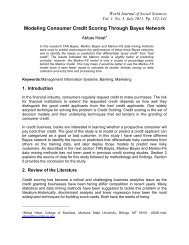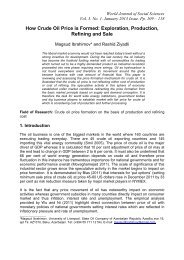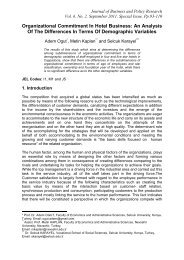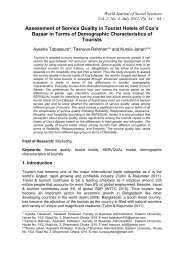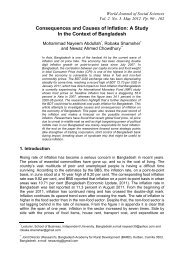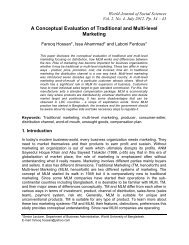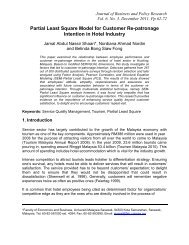The Determinant and Trade Potential of Export of the ... - Wbiaus.org
The Determinant and Trade Potential of Export of the ... - Wbiaus.org
The Determinant and Trade Potential of Export of the ... - Wbiaus.org
Create successful ePaper yourself
Turn your PDF publications into a flip-book with our unique Google optimized e-Paper software.
Hermawangeographical distance to trade flows between bilateral countries or regions. <strong>The</strong> <strong>the</strong>orypioneered by Tinbergen (1962) <strong>and</strong> Pöyhönen (1963) studies <strong>the</strong> effect <strong>of</strong> nationalincome <strong>and</strong> geographical distance to imports <strong>of</strong> commodities 1 . Originated fromNewtonian <strong>the</strong>ory <strong>of</strong> universal gravity, <strong>the</strong> model postulates that <strong>the</strong> force between twoobjects is determined by <strong>the</strong>ir body mass <strong>and</strong> <strong>the</strong> distance between <strong>the</strong>m. Thus, in aneconophysics sense, <strong>the</strong> trade flow represents <strong>the</strong> gravitational force, <strong>the</strong> economicscale <strong>and</strong> wealth <strong>of</strong> two countries correspond to body mass <strong>of</strong> each subject, <strong>and</strong> <strong>the</strong>geographical distance is exactly <strong>the</strong> denotation <strong>of</strong> physical distance. Recently, thismodel is employed in social science problem solving in order to explain <strong>the</strong> flows <strong>of</strong> notonly trade but also immigrants <strong>and</strong> money repatriation, foreign direct investment, etc.This paper utilizes a gravity model to examine <strong>the</strong> bilateral export flows betweenIndonesia <strong>and</strong> selected trading partner countries, specifically in downstream <strong>and</strong>midstream textile industries (code 26 <strong>and</strong> 65 St<strong>and</strong>ard International <strong>Trade</strong>Classification/SITC Revision 3). <strong>The</strong> objectives <strong>of</strong> this research are tw<strong>of</strong>old: first,underst<strong>and</strong>ing <strong>the</strong> nature <strong>of</strong> Indonesian manufactured textile product exports. Withregard to <strong>the</strong> gravity model, <strong>the</strong> results should show <strong>the</strong> role <strong>of</strong> independent variables(economic size/wealth, geographical distance <strong>and</strong> o<strong>the</strong>r control variables) that influence<strong>the</strong> export. <strong>The</strong> results also determine <strong>the</strong> significance <strong>and</strong> direction <strong>of</strong> <strong>the</strong> effect. <strong>The</strong>second objective is to reveal <strong>the</strong> trade potential between Indonesia <strong>and</strong> its selectedtrading partners regarding <strong>the</strong> specific commodity. <strong>The</strong> estimation results from <strong>the</strong>gravity model will be <strong>the</strong> tool to predict <strong>the</strong> export value in <strong>the</strong> same trading partner <strong>and</strong><strong>the</strong> same period <strong>of</strong> analysis. <strong>The</strong>n, <strong>the</strong> comparison between predicted <strong>and</strong> actual exportvalue yields <strong>the</strong> projection <strong>of</strong> trade potential, which refers to under trade or overtradecircumstances between Indonesia <strong>and</strong> its trading partner. Ultimately, <strong>the</strong> purpose <strong>of</strong> thisresearch paper is to contribute to <strong>the</strong> study <strong>of</strong> international trade. Fur<strong>the</strong>rmore, it shouldillustrate <strong>the</strong> clear picture <strong>of</strong> <strong>the</strong> Indonesian manufactured textile industry, especially in<strong>the</strong> global market view. <strong>The</strong>refore, <strong>the</strong> hypo<strong>the</strong>ses <strong>of</strong> this research are:- <strong>The</strong> size <strong>of</strong> economy (GDP, per capita GDP <strong>and</strong> population) <strong>and</strong> <strong>the</strong> distancebetween Indonesia <strong>and</strong> its selected trading partner significantly influence <strong>the</strong> exportvalue <strong>of</strong> Indonesian textile industry;- Under <strong>the</strong> gravity model, <strong>the</strong> Indonesian textile industry is facing under traded <strong>and</strong>over traded situations with its selected trading partners.This paper is <strong>org</strong>anized as follows. Section 2 elaborates on <strong>the</strong> importance <strong>and</strong> <strong>the</strong>background problem in <strong>the</strong> Indonesian textile industry. Section 3 reviews <strong>the</strong> existingliterature which supports <strong>the</strong> <strong>the</strong>oretical implications <strong>and</strong> recent previous empiricalfindings <strong>of</strong> <strong>the</strong> gravity model. Section 4 presents <strong>the</strong> methodology <strong>and</strong> data <strong>of</strong> thisstudy, followed by analysis <strong>of</strong> <strong>the</strong> empirical findings in Section 5. Finally, Section 6provides <strong>the</strong> conclusion <strong>and</strong> limitations <strong>of</strong> <strong>the</strong> study.2. Indonesian Textile Industry<strong>The</strong> Indonesian textile industry consists <strong>of</strong> three mainstream industries: (i) <strong>the</strong> upstreamindustry which produces fibre (code 26 SITC Rev.3), (ii) <strong>the</strong> midstream industry whichmanufactures yarn <strong>and</strong> fabrics (code 65 SITC Rev.3), <strong>and</strong> (iii) <strong>the</strong> downstream industrywhich is <strong>the</strong> garment industry (code 84 SITC Rev.3) (Pratiwi Anwar 2000). For a14



